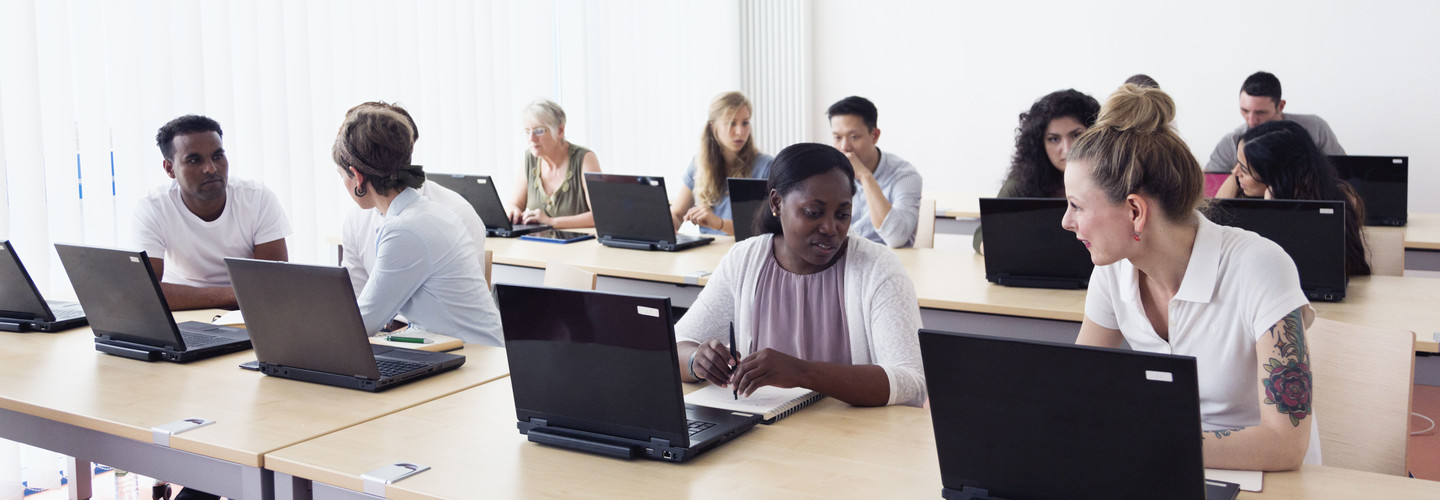For Some Colleges, 1:1 Programs Are Starting to Make Sense
One-to-one device initiatives traditionally have been the province of K–12 education, but recent rollouts in higher education have me wondering if this trend is coming to colleges, too. Like K–12 districts, higher education institutions will have to assess the pros and cons of one-to-one versus bring your own device on a case-by-case basis, but some are already choosing to issue devices to give students a standardized, consistent computing experience.
According to one report, more than half of K–12 teachers now have one-to-one student-to-device ratios in their schools, up significantly from last year. As one higher education leader points out, many of our future college students have grown up with these types of programs. On one hand, students accustomed to standard-issue devices, with their preset apps and ease of maintenance, may be more likely to expect similar conveniences on campus. On the other hand, computing requirements vary so widely in college — for example, a business major will have different storage and software needs than a game design major — that BYOD may be a better fit.
For now, I think it’s too early to say how widespread one-to-one programs might become in higher education. But the prospect is interesting, and it’s worth noting that a few institutions are embracing it.
Six Keys to a Successful One-to-One Program
Next year, Central Methodist University’s College of Liberal Arts and Sciences in Missouri will launch Digital U. It’s aimed, in part, at familiarizing students with the tech tools they’re likely to encounter in the workforce. As part of the program, all of the college’s full-time students will get their own 64 GB iPad Pro to keep after they graduate. One facet of Digital U that I found interesting is this: Given the goal of expanding learning opportunities, professors wanted to make sure the iPads didn’t create a distraction. So instructors will have access to an app that locks students’ devices while in the classroom, a level of control that’s not possible with BYOD.
The College of Education at Southeast Missouri State University was an even earlier adopter of one-to-one in higher education. In 2014, students in the Teacher Education Program were given the opportunity to rent an iPad (rental fees also covered college-owned apps, replacement insurance, a two-year upgrade and the opportunity to buy the device for a modest cost at graduation). Arkansas State University also chose a rental program for iPads in its institution-wide one-to-one program.
One justification for SMSU’s program, according to an analysis by Professors Daryl Fridley and Diana Rogers-Adkinson, was that graduates would be going on to teach in local school districts that were already using one-to-one, making it beneficial for them to be familiar with the “wired environment.” They also noted that SMSU considered a BYOD program instead, but chose a one-to-one arrangement because of greater ease of addressing considerations such as storage, security and integration with the learning management system. Other factors were the need to create a program that was financially self-sustaining and a desire to take advantage of Apple support resources.
The professors identified six considerations that can help institutions more effectively implement programs like this one:
-
Clear objectives
-
Effective decision-making
-
Stakeholder involvement
-
Training
-
Appropriate infrastructure
-
Long-term sustainability
One-to-One Puts Another Option on the Table
Institutions weighing one-to-one programs against BYOD will face many of the same pro/con considerations that school districts face: primarily, cost, maintenance and access to standardized applications. Given the prevalence of BYOD on campus, many institutions address this last factor using virtual desktop infrastructure solutions that let students access a suite of institutional software on their own devices.
Security, of course, is another concern. IT teams have ample tools at their disposal, such as enterprise mobility management solutions, to ensure that students and staff performing work on personal devices don’t compromise institutional data. But another strategy, of course, is to minimize the use of those personal devices by equipping everyone with the same device and giving IT a more hands-on role in ensuring they comply with recommended security requirements.
Ultimately, the best measure of any technology program is how well it works to enhance students’ learning. A Michigan State University assessment of one-to-one laptop programs in K–12 analyzed research studies conducted over a 15-year period. It found positive results in a variety of areas, from test scores to engagement.
Technology solutions are never a one-size-fits-all proposition, so it’s unlikely that we’ll see a wholesale adoption of one-to-one programs on campus. But it’s good to know that institutions have a wider range of options at their disposal so they can decide which program is best for either an institution as a whole or, more likely, for an individual department or program.
This article is part of EdTech: Focus on Higher Education’s UniversITy blog series.









